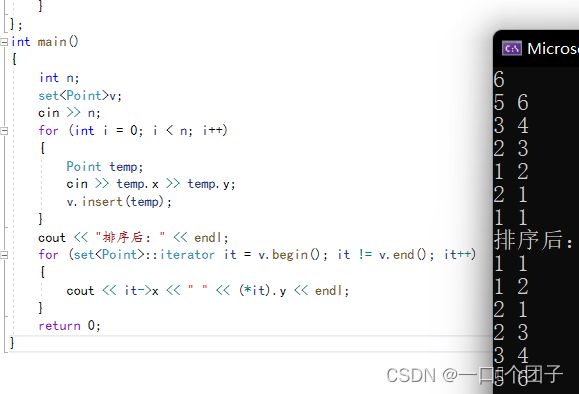蓝桥杯-常用STL(二)
常用STL
- 1.集合
- 2.set的基础使用
-
- 2.1引入库
- 2.2插入元素
- 2.3删除元素
- 2.4判断元素是否存在
- 2.5遍历元素
- 2.6清空
- 3.set与结构体
1.集合
集合是数学中的一个基本概念,通俗的理解,集合就是一些不重复的数据组成的。比如
{1,2,3}就是一个有1,2,3三个元素的集合。在C++中,我们常用的集合是set。
2.set的基础使用
2.1引入库
C++中set的实现是在一个using namespace std;
2.2插入元素
C++中用insert()函数向集合中插入一个新的元素。注意如果集合中已经存在了某个元素,再次插入不会产生任何效果,集合中是不会出现重复元素的。
#include 2.3删除元素
C++中用erase()函数删除集合中的一个元素,如果集合不存在这个元素,不进行任何操作。
#include 2.4判断元素是否存在
C++中如果你想知道某个元素是否在集合中出现,你可以直接用count()函数。如果集合中存在我们要查找的元素,返回1,否则返回0。
#include 2.5遍历元素
C++通过迭代器可以访问集合中的每个元素,迭代器就好像一根手指指向set中发某个元素。通过操作这个手指,我们可以改变它要指向的元素。通过*(解引用操作符)操作可以获取迭代器指向的元素。通过++操作让迭代器指向下一个元素,同理,--操作让迭代器指向上一个元素。
迭代器的写法比较固定,set就定义了一个指向set这种集合的迭代器it,T是任意的数据类型。其中::iterator是固定的写法。begin函数返回容器中起始元素的迭代器,end函数返回容器的尾后迭代器。
#include 
❗**注意:**在C++中遍历set是从小到大遍历的,也就是说set会帮我们排好序。
2.6清空
C++中调用clear()函数就可以清空set,同时会清空set占用的内存。
3.set与结构体
set经常会配合结构体来使用,用set来储存结构体和vector有些区别。正如我们前面所说的那样,set是需要经过排序的,系统自带的数据类型有默认的比较大小的规则,而我们自定义的结构体,系统是不可能知道这个结构体比较大小的方式的。所以,我们需要用一种方式来告诉系统怎么比较这个结构体的大小。其中一种方法叫运算符重载,我们需要重新定义小于符号。
struct Node
{
int x, y;
bool operator<(const Node& rhs)const
{
if (x == rhs.x)
return y < rhs.y;
else
return x < rhs.x;
}
};
operator<表示我们要重载运算符<,可以看成一个函数名。rhs是“right hand side”的简称,有右操作数的意思,这里我们定义为一个const引用。因为该运算符重载定义在结构体内部,左操作数就当前调用operator<的对象。
特别要注意,不要漏掉最后的const,const函数表示不能对其他数据成员进行修改操作,并且const对象不能调用非const成员函数,只允许调用const成员函数。
上面重载规定了排序方式为:优先依照x从小到大排序,如果x相同,那么再按照y从小到大排序。经过了<运算符重载的结构体,我们就可以比较两个Node对象的大小了,因此可以直接储存在set中了。
✅通过上面的学习,我们学会用set来储存一个二维坐标系上的点的集合。接下来,我们来给这个结构体添加<的运算符重载,让编译器知道该怎么对这个结构体比较大小。
#include 
